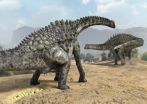(Press-News.org) A study headed by the Miquel Crusafont Catalan Palaeontology Institute has for the first time documented detailed records of dinosaur egg fossils in the Coll de Nargó archaeological site in Lleida, Spain. Up until now, only one type of dinosaur egg had been documented in the region.
The archaeological site in Coll de Nargó containing dinosaur eggs lies some 8 kilometres to the west of the town that bears the same name in the province of Lleida. This region is home to different types of geological formations, including the Areniscas de Arén Formation and the Tremp Formation, which have provided a rich and varied yield of dinosaur fossils through the entire Pyrenees region.
"Eggshells, eggs and nests were found in abundance and they all belong to dinosaurs, sauropods in particular. Up until now, only one type of dinosaur egg had been documented in the region: Megaloolithus siruguei. After analysing more than 25 stratus throughout the Tremp Formation, a minimum of four different additional types were identified: Cairanoolithus roussetensis, Megaloolithus aureliensis, Megaloolithus siruguei and Megaloolithus baghensis", as explained to SINC by Albert García Sellés from the Miquel Crusafont Catalan Palaeontology Institute and lead author of the study.
One of the main problems faced by palaeontologists when studying fossil remains is determining the age of the sediments that contain them. There are fossils known as "guide fossils" whose characteristics allow for the age of rocks to be deduced. However, these fossils are frequent in marine sediments but more scarce and difficult to find in land sediments.
"It has come to light that the different types of eggs (oospecies) are located at very specific time intervals. This allows us to create biochronological scales with a precise dating capacity. In short, thanks to the collection of oospecies found in Coll de Nargó we have been able to determine the age of the site at between 71 and 67 million years," ensures the expert.
The paleontological sites in the south of Europe containing dinosaur remains have a high scientific value since they allow us to understand and thus reconstruct the ecosystems at the end of the Mesozoic Era.
The latest scientific investigations show that the dinosaur fauna of the European Continent living for a short time before the great extinction some 66 million years ago can be found exactly on the southern side of the Pyrenees.
A connection between French and Spanish dinosaurs
The discovery of Cairanoolithus fossils in this area is an important finding. Given that this type of eggs is only known in the south of France, they are the first of their kind found in the Iberian Peninsula.
According to García Sellés, this discovery constitutes a new proof of the connection between dinosaur fauna in France and in the Iberian Peninsula some 70 million years ago.
Furthermore, finding dinosaur eggs and nests in more than 25 stratigraphic levels provides clear evidence that these sauropods used the Coll de Nargó region as a nesting area for millions of years.
"We had never found so many nests in the one area before. In addition, the presence of various oospecies at the same level suggests that different types of dinosaurs shared the same nesting area," concludes the scientist.
INFORMATION:
References:
Albert G. Sellés, Ana María Bravo, Xavier Delclòs, Ferran Colombo, Xavier Martí c, Jaume Ortega-Blanco, Carme Parellada c, Àngel Galobart. "Dinosaur eggs in the Upper Cretaceous of the Coll de Nargó area, Lleida Province, south-central Pyrenees, Spain: Oodiversity, biostratigraphy and their implications", Cretaceous Research 40: 10 -20, 2013.
4 dinosaur egg species identified in Lleida
2013-03-12
ELSE PRESS RELEASES FROM THIS DATE:
Does expressing anger on online rant-sites make you feel better or worse?
2013-03-12
New Rochelle, NY, March 12, 2013—Little is known about the value and emotional consequences of expressing anger on the Internet. Rant-sites provide an outlet for anonymous, angry outbursts. How people feel after reading and writing rants and the effects of this behavior is explored in an article in Cyberpsychology, Behavior, and Social Networking, (http://www.liebertpub.com/cyber) a peer-reviewed journal from Mary Ann Liebert, Inc., publishers (http://www.liebertpub.com). The article is available online on the Cyberpsychology, Behavior, and Social Networking (http://www.liebertpub.com/cyber) ...
Young pigs prefer traditional soybean diet
2013-03-12
Des Moines, IA – Pigs aren't known for being picky, but new research shows they avoid bitter tastes when they can.
In a new study of nursery pig diets, researchers from the University of Alberta offered pigs different amounts of soybean meal, napus canola meal and juncea canola meal. They found that pigs ate more soybean meal when given a choice.
Napus canola meal and juncea canola meal come from rapeseed and mustard greens, respectively. Canola meals are less expensive than soybean meal. If producers can replace soybean meal in swine diets, they could produce pork ...
Updated 'stereo EEG' workflow simplifies planning of epilepsy surgery
2013-03-12
Philadelphia, Pa. (March 12, 2013) – For patients with "drug-resistant" epilepsy requiring surgery, an updated stereoelectroencephalography (SEEG) technique provides a more efficient process for obtaining critical data for surgical planning, according to a study in the March issue of Neurosurgery, official journal of the Congress of Neurological Surgeons. The journal is published by Lippincott Williams & Wilkins, a part of Wolters Kluwer Health.
"SEEG is a safe and accurate procedure for invasive assessment of the epileptogenic zone," according to the new report by Dr. ...
Some bacteria may protect against disease caused by stomach infection
2013-03-12
Half of the world's human population is infected with the stomach bacteria called Helicobacter pylori, yet it causes disease in only about 10 percent of those infected. Other bacteria living in the stomach may be a key factor in whether or not H. pylori causes disease, according to a new study led by scientists at the University of California, Santa Cruz.
"People tend to think of the stomach as a relatively sterile environment, but it's actually populated with microbes," said Karen Ottemann, professor and chair of microbiology and environmental toxicology at UC Santa ...
Nearly a third of antibiotic prescriptions for dialysis patients inappropriate
2013-03-12
Patients who receive hemodialysis are at a significant risk of developing infections, a leading cause of hospitalization and death in this patient population. A new study highlights the need to improve antibiotic use in outpatient dialysis facilities as data shows nearly a third of antibiotic prescriptions are deemed inappropriate. The study is published in the April issue of Infection Control and Hospital Epidemiology, the journal of the Society for Healthcare Epidemiology of America.
The United States Renal Data System reported that from 1993 to 2010, the number of ...
Computer model may help athletes and soldiers avoid brain damage and concussions
2013-03-12
Concussions can occur in sports and in combat, but health experts do not know precisely which jolts, collisions and awkward head movements during these activities pose the greatest risks to the brain. To find out, Johns Hopkins engineers have developed a powerful new computer-based process that helps identify the dangerous conditions that lead to concussion-related brain injuries. This approach could lead to new medical treatment options and some sports rule changes to reduce brain trauma among players.
The research comes at a time when greater attention is being paid ...
BUSM study reveals therapeutic targets to alter inflammation, type 2 diabetes
2013-03-12
New research from Boston University School of Medicine (BUSM) reveals that B cells regulate obesity-associated inflammation and type 2 diabetes through two specific mechanisms. The study, published in the Proceedings of the National Academies of Sciences, indicates the importance of continuing to explore B cells as a therapeutic target to treat these diseases. Barbara Nikolajczyk, PhD, associate professor of microbiology at BUSM, is the study's senior author.
The incidence of diabetes continues to rise at alarming rates. According to the National Institute of Diabetes ...
Sri Lankan snake study reveals new species, rich biodiversity in island country
2013-03-12
WASHINGTON Alex Pyron's expertise is in family trees. Who is related to whom, who begat whom, how did they get where they are now. But not for humans: reptiles.
In 2011, his fieldwork in Sri Lanka studying snake diversity on the island led him to confirm the identity of 60 known species of snakes. With Sri Lankan collaborators, Ruchira Somaweera, an author on snakes and expert on amphibians and reptiles, and Dushantha Kandambi, a local naturalist and snake expert, the team collected 60 species of snakes and of those, Dr. Pyron used DNA sequencing technology on 40 of them. ...
Sleator lab identifies single point mutation in Listeria monocytogenes
2013-03-12
The bacterial foodborne pathogen, Listeria monocytogenes is the causative agent of listeriosis—a debilitating disease linked with ~2,500 illnesses and more than 500 deaths per annum in the US alone. A characteristic feature of L. monocytogenes is its ability to grow at refrigeration temperatures and in the presence of high concentrations of salt—traditional food preservation techniques, which arrest the growth of most other pathogens.
Work in the Sleator lab has shown that the bacterium protects itself from such stresses by twisting into a protective corkscrew type shape ...
AGU journal highlights - March 12, 2013
2013-03-12
The following highlights summarize research papers that have been recently published in Geophysical Research Letters (GRL), Water Resources Research (WRR), and Journal of Geophysical Research-Biogeosciences, (JGR-G).
In this release:
1. Canadian Arctic glacier melt accelerating, irreversible
2. Eyjafjallajökull's iron-rich ash fertilized North Atlantic Ocean
3. A seismometer in orbit around Earth
4. Distinguishing drought and water scarcity
5. Evaluating the seismic risk of mineral carbon sequestration
6. Tracing nitrate in watersheds
7. Devastating East African ...


